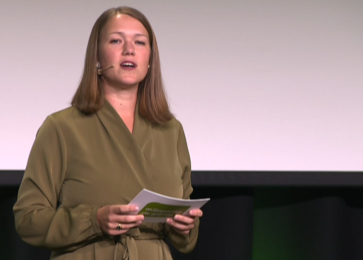Norwegian Labour Party leader Jonas Gahr Støre is set to become Norway’s prime minister, leading a new left-center government that aims to reduce social differences and cut emissions without dismantling the oil industry. The much-hyped Greens Party ended up winning less than 4 percent of the vote, meaning it won’t be the force in national climate policy that it had hoped to be.

Current Prime Minister Erna Solberg of the Conservatives, meanwhile, conceded that the voters “want a new government” after eight years of her own right-center coalitions. “It’s over for this time,” Solberg told still-cheering supporters Monday night, “and I say ‘this time’ because we have ambitions for a strong comeback” in 2025.”
She had already called Støre to congratulate him on his election victory that enables him to build a bigger coalition than she could, with a solid majority in Parliament. Labour had won 26.4 percent of the vote compared to her Conservatives’ 20.4 percent after 94 percent of the votes were counted Monday night. Both of their parties lost ground compared to the last election in 2017, however, as did two of Solberg’s former government partners, the Christian Democrats and the right-wing Progress Party.
The far-left Reds Party won the most impressive gain, doubling its voter support and leaping from just one seat in Parliament this past term to eight. Reds leader Bjørnar Moxnes, who has proven himself to be a well-spoken and effective Member of Parliament, downplayed his party’s Marxist past at a late-night post-election meeting of all party leaders. He vowed instead to merely work closely with labour unions, to battle privatization of such welfare services as day care and health care, and join Støre in fighting social differences among Norwegians. That’s expected to include higher taxes for the wealthy and lower taxes for those with low to moderate incomes.

Støre, a former foreign minister known for diplomatic talent and keen to seek compromises, wants to form a new government with the Center Party (which won 13.7 percent of the vote) and Socialist Left (SV) even though Labour’s two prospective partners disagree sharply on many issues, especially climate and the oil industry. Together, though, the three parties would have a majority in Parliament and an even bigger one through a support agreement from the Reds.
Center’s leader Trygve Slagsvold Vedum, a farmer from Hedmark keen on protecting rural interests, finally conceded the prime minister’s post to Støre Monday night but has wanted Labour and Center to rule alone without SV. Støre faces a tough job hammering out a government platform among the three, but says he’ll speak with them first, then with the Reds and also the Greens, although the Greens won’t support any government that won’t halt oil exploration.
The Greens ended up with just 3.8 percent of the vote, much less than expected in what many had called a “climate election.” It turned disappointing for the climate movement. Greens leader Une Bastholm refused to offer any explanation for the poor voter support, preferring instead to note that it was better than the 3.2 percent they won in 2017 and gives them at least two seats in Parliament instead of just the one they’ve held in the last session.

Bastholm vowed again Monday night to be “uncompromising” on the Greens’ climate and oil policy, which may explain why Norwegian voters didn’t offer more support for the party. Election analysts told state broadcaster NRK Monday evening that the Greens should have had a broader base of issues instead of primarily climate policy. Some also suggested that the Greens have been “too confrontational” in Oslo, where they hold city government power with Labour and have angered many residents by removing street parking and making it difficult to use private cars.
Guri Melby of the Liberal Party, which won 4.4 percent of the vote, insists it was still a “climate election” even though victorious Labour won’t curtail oil and gas any more than the Conservatives side will. Melby said Norway simply must get serious about cutting its own emissions and her small party is now free to vote with SV, the Greens and the Reds, for example, on climate issues. All four bigger parties, however, want to maintain the oil and gas industry, so not much may actually change.
Faring the worst in Monday’s election was the Christian Democrats party, now part of Solberg’s government coalition but falling under the 4 percent limit set for full representation in Parliament.
Outgoing Prime Minister Solberg remarked in her own concession speech Monday night that Støre now faces “demanding negotiations” with both the Center Party and SV to form a government. “It will be exciting for us all,” she said, with a wry smile. Støre said he’ll take the time needed to form a new government, with Solberg staying on until one is in place, possibly not until Stortinget opens in October.
newsinenglish.no/Nina Berglund

